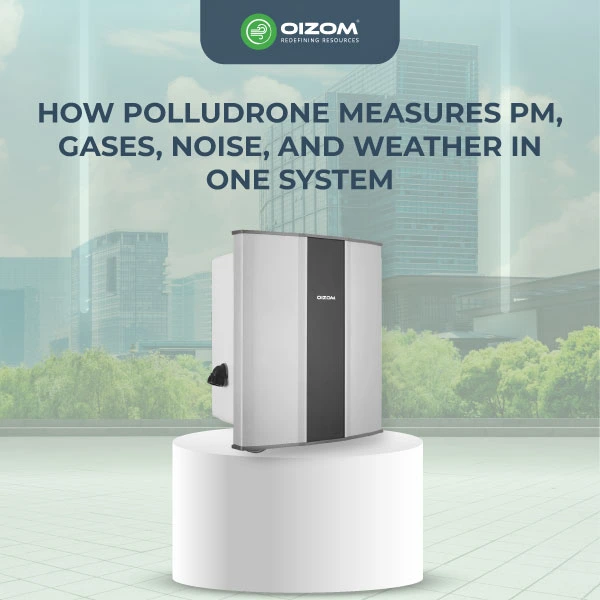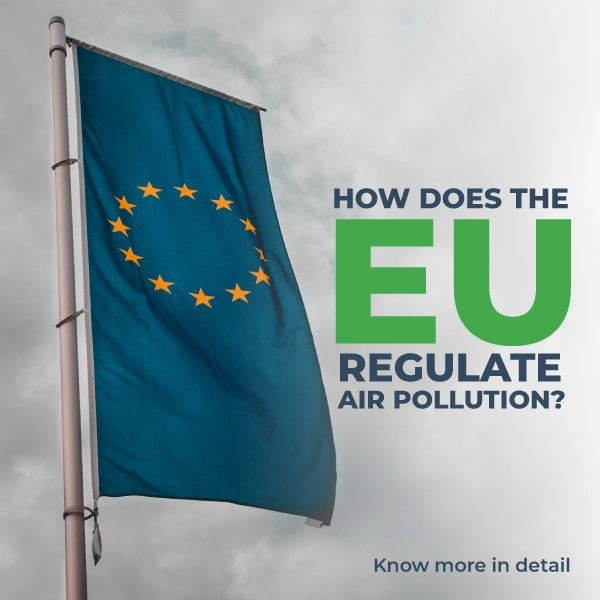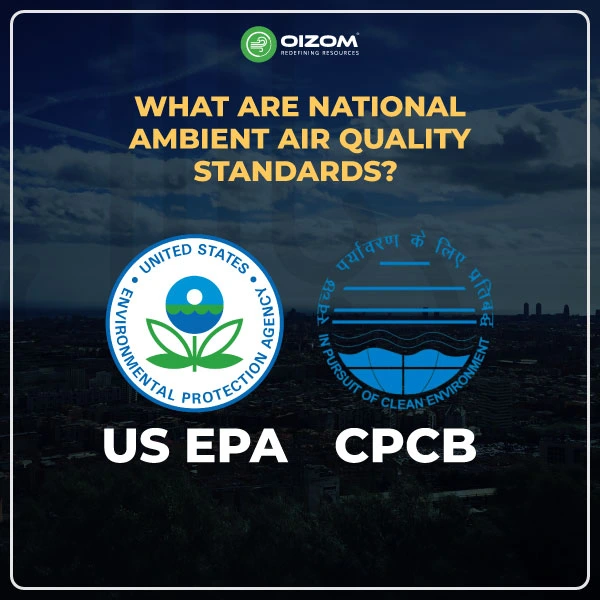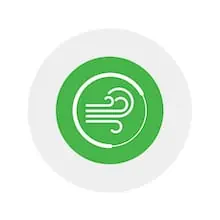What if one device could measure everything in the air, at once, and in real time? From fine dust particles to harmful gases, from changing weather to rising noise levels, air quality is influenced by a lot more than just one factor. And if you’re trying to monitor it, using separate instruments for each parameter can quickly become complicated and expensive.
That’s exactly why we built Polludrone. Polludrone is a compact, all-in-one ambient air quality monitoring system that keeps track of what’s in the air, particulate matter (PM1, PM2.5, PM10, and even PM100), gases like NO₂, NO, CO, CO2, H2S, SO₂, and O₃, ambient noise, and even weather conditions like temperature, humidity, wind, and rainfall.
It uses advanced sensors, laser-based for particles, electrochemical, NDIR for gases, and smart weather modules to collect accurate, real-time data. Whether it’s installed in a city, near a factory, or at a research site, Polludrone helps you see the full environmental picture without the complexity of multiple devices.
In this blog, we’ll walk you through how Polludrone measures each parameter and how having all this data in one place can make monitoring easier, smarter, and far more effective.
What is Polludrone?
Polludrone is Oizom’s advanced air quality monitoring system, designed to measure multiple environmental parameters in real time. Unlike large and complex CAAQMS setups, Polludrone is compact, weather-resistant, and easy to install, making it perfect for both city and industrial use. Whether it’s placed at a busy traffic intersection or around a factory, Polludrone runs 24/7, even in extreme outdoor conditions.
What makes it stand out is its patented e-breathing technology, which pulls in air just like humans breathe, helping sensors collect more accurate data. You can also customize the sensors depending on what you need to monitor, whether it’s for meeting government regulations, tracking emissions, or understanding the health impact of air pollution in a specific area.
Particulate Matter Monitoring (PM1, PM2.5, PM10 and PM100)
Polludrone measures PM1, PM2.5, PM10, and PM100 in real time using advanced laser scattering technology. It accurately detects the size and concentration of airborne particles, helping industries, cities, and researchers monitor dust levels, track pollution trends, and ensure regulatory compliance.
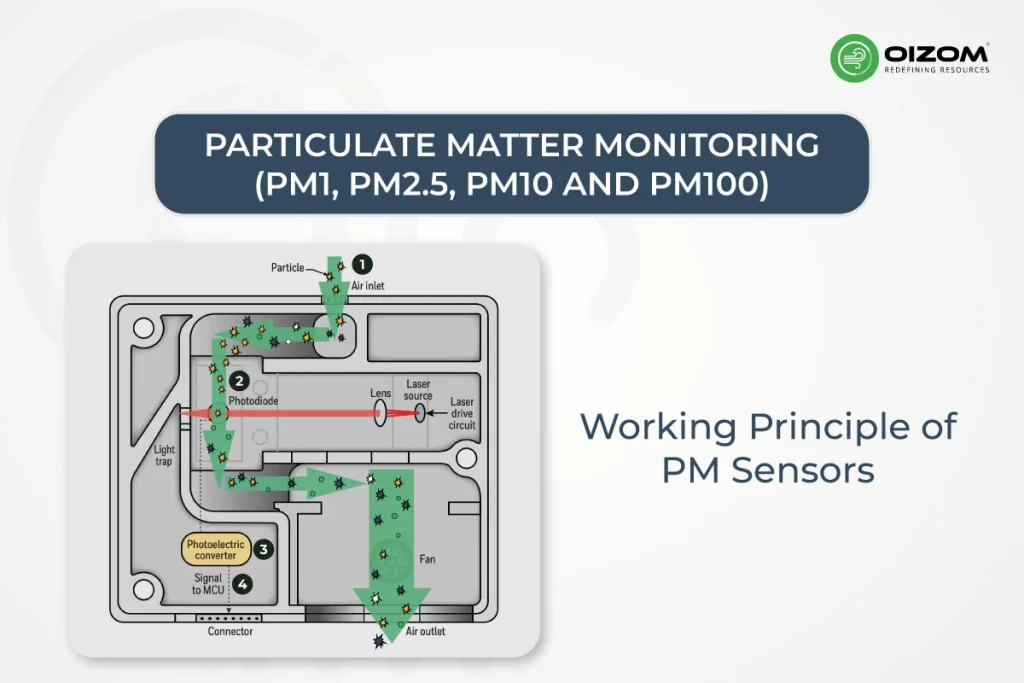
Working Principle of PM Sensors
Polludrone uses laser scattering technology to monitor particulate matter in the air. Here’s how it works: as air is drawn into the sensor chamber, a laser beam hits the particles suspended in the air. These particles scatter the light in different directions, and based on the pattern and intensity of this scattering, the device can calculate both the size and quantity of the particles present.
This light pattern helps the device determine both the size and concentration of particles in the air. Using this method, Polludrone accurately differentiates between PM1, PM2.5, PM10, and PM100, all of which represent different particle sizes in micrometers.
- PM1 can reach deep into the lungs and bloodstream.
- PM2.5 is common in urban pollution and a major health hazard.
- PM10 and PM100 are larger dust particles that affect air quality in construction and mining sites.
What makes Polludrone reliable is its active airflow mechanism (e-breathing), which ensures fresh and representative air samples are always analyzed, avoiding false readings from stagnant air.
The result? You get precise, real-time particulate data that you can use to assess air quality instantly, without waiting for lab reports or manual sampling.
Importance of PM Monitoring
Monitoring particulate matter isn’t just about meeting regulations but protecting people. PM2.5 and PM10 are especially dangerous because they can enter deep into the lungs and even the bloodstream, causing respiratory and cardiovascular issues. Regulatory bodies like the CPCB (India), the EPA (USA), and the WHO have set strict exposure limits for these particles.
Polludrone provides high-resolution PM data, helping industries, municipalities, and researchers track pollution trends, identify sources, and ensure public safety, indoors and outdoors.
Did you know, Polludrone, equipped with an MCERTS-certified PM sensor (PM2.5 and PM10), the device delivers globally trusted and highly accurate data.
Use Cases of PM Data from Polludrone
Polludrone’s PM monitoring is widely used across various sectors:
- Construction sites for dust emission tracking and suppression
- Traffic zones to study pollution spikes during peak hours
- Residential areas for community health assessments
- Industries to monitor compliance with air quality norms
- Smart cities to power AQI displays and data-driven planning
A practical example comes from Odisha, where the State Pollution Control Board set up continuous PM monitoring across key locations. The goal was to better understand pollution patterns, improve regulatory action, and guide future interventions, all using reliable, real-time data. View the case study.
Whether you’re a factory owner, urban planner, or environmental consultant, Polludrone helps you make informed decisions with reliable PM data.
Gaseous Pollutants Monitoring (NO₂, CO, SO₂, O₃, etc.)
Polludrone monitors harmful gases like NO₂, CO, SO₂, and O₃ using advanced electrochemical and NDIR sensors. With real-time data and high sensitivity, it helps industries and cities track emissions, ensure compliance, and safeguard public health.
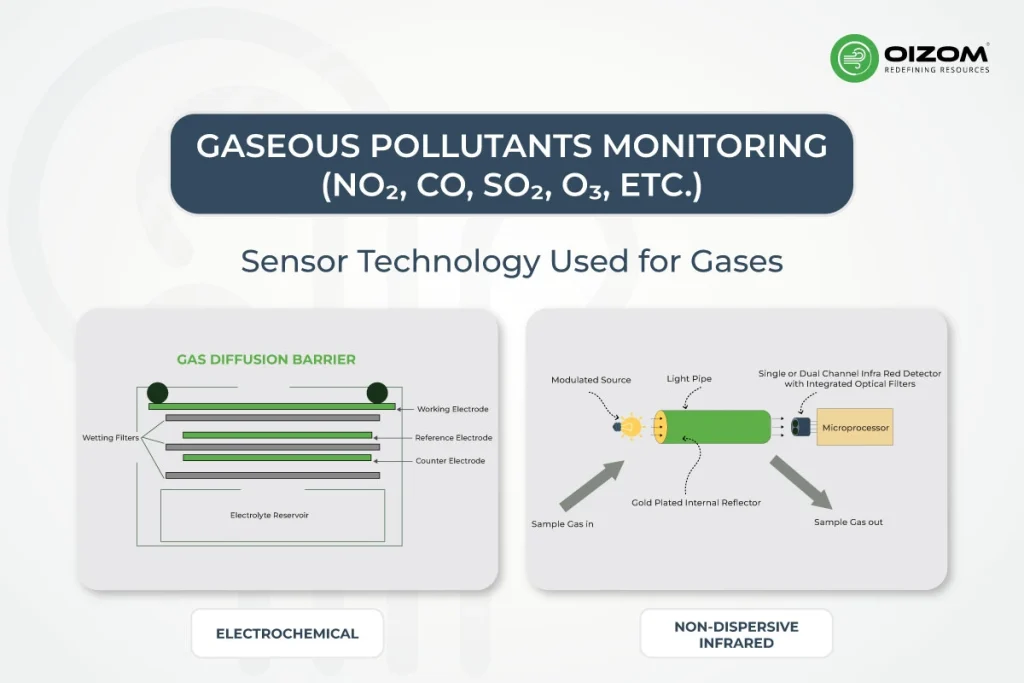
Sensor Technology Used for Gases
Polludrone uses a combination of electrochemical and NDIR (Non-Dispersive Infrared) sensors to monitor gaseous pollutants such as NO₂, CO, SO₂, O₃, NO, and CO₂. Each sensing technology is selected based on the target gas’s behavior to ensure accuracy and reliability in real-world conditions.
Electrochemical sensors are ideal for trace-level detection of gases like NO₂, CO, and SO₂, offering high sensitivity, low detection limits, and minimal cross-interference. For gases like CO₂, Polludrone uses NDIR sensors, which work by measuring the absorption of infrared light as it passes through a sample of air. This method provides stable, precise measurements over time with low maintenance.
To ensure long-term performance, each sensor is calibrated with known gas concentrations during manufacturing and can be recalibrated in the field when needed. This ensures data you can trust, day after day.
Accurate air quality data starts with precise calibration. At Oizom, we ensure every gas sensor in Polludrone delivers reliable results. To do that, we carefully calibrate each sensor using standard gases and trusted tools. This includes performing zero and span checks in a controlled lab setting, following the guidelines from the USEPA’s Quality Assurance Handbook (Section 12.2).
We also use NIST-traceable gas standards, which means the calibration process meets international accuracy benchmarks. The result? You get data that’s not just real-time, but accurate, consistent, and ready to support critical decisions.
Why Gas Monitoring Matters
Gaseous pollutants like NO₂ and O₃ are linked to respiratory illnesses, cardiovascular problems, and reduced air quality. Monitoring these gases is critical for regulatory compliance, public health, and environmental planning.
Polludrone helps by offering real-time gas data, enabling quick response to pollution events and better planning for cleaner air.
Real-time monitoring plays a crucial role here. For instance, in a high-security and sensitive zone like the Bhabha Atomic Research Centre (BARC) in Mumbai, continuous gas monitoring was essential to maintain safe ambient conditions. A multi-parameter system was implemented to track pollutants like NO₂, O₃, and CO, along with particulate matter and meteorological data. This helped streamline their environmental management strategy and improve responsiveness to air quality fluctuations. Explore the case study.
Real-World Applications
Polludrone’s gas monitoring is widely used in:
- Industrial zones for emission tracking and pollution control
- City perimeters and roadsides to monitor traffic-related gases
- Smart city air quality networks for live AQI dashboards and alerts
Its reliable, real-time data helps decision-makers act fast and stay compliant.
Ambient Noise Monitoring
Noise pollution is a growing concern in many places today. Keeping track of sound levels is important for making cities, workplaces, and public spaces healthier and more comfortable for everyone.
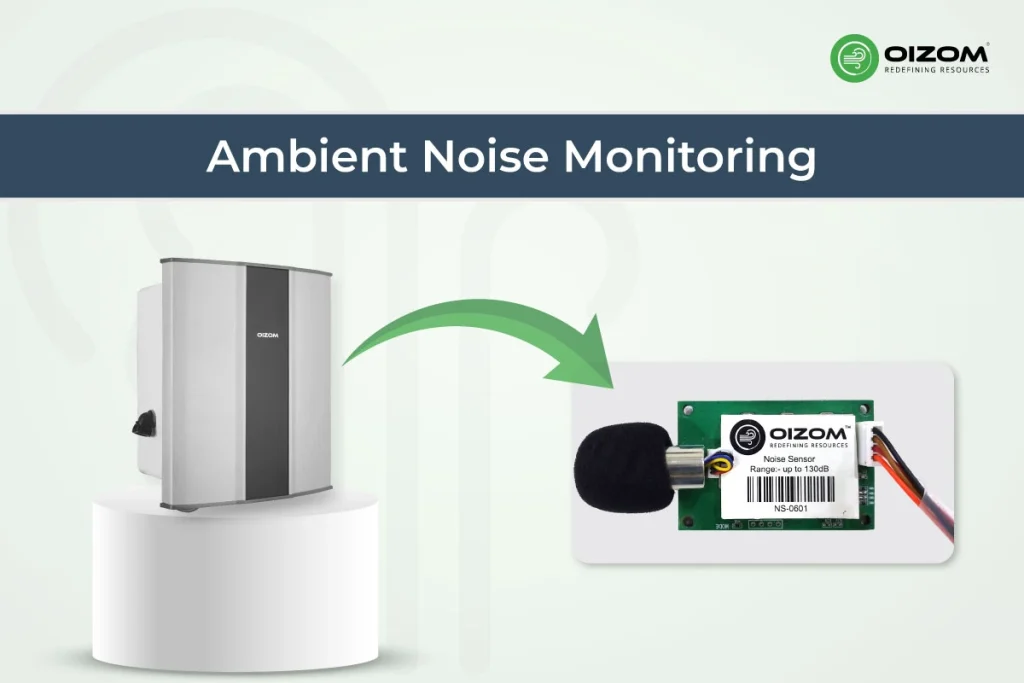
How Polludrone Measures Noise
Polludrone is equipped with an Oizom’s Class 2 Noise Sensor, which accurately measures noise levels in the ambient air. The sensor measures noise in the A-weighted decibel scale (dB(A)), which closely reflects human hearing sensitivity. It samples sound levels at regular intervals, typically every 2 minutes on a special request, providing real-time data on environmental noise fluctuations. NOTE: Class I Noise sensors are available as optional features upon specific customer request.
The sensor complies with IEC 61672 standards for sound level meters, offering ±1.0 dB resolution, making it suitable for long-term environmental noise monitoring without the need for bulky, high-maintenance equipment. Polludrone’s noise data can be integrated with air pollution and weather parameters, offering a comprehensive view of environmental conditions for smarter analysis and reporting.
When and Where Noise Data is Valuable
Noise pollution is a growing concern in urban and industrial areas, impacting public health, productivity, and overall quality of life. Monitoring sound levels is essential for creating healthier, more livable environments. Did you know this? The EEA also estimates that 22 million people suffer from chronic high levels of annoyance and 6.5 million people suffer from chronic high levels of sleep disturbance as a result of long-term noise exposure.
Polludrone’s noise monitoring capabilities are valuable in various settings:
- Urban Areas: To assess and manage noise pollution from traffic, construction, and public events.
- Highways and Roadsides: For evaluating vehicle noise and implementing noise reduction strategies.
- Industrial Zones: To monitor machinery noise and ensure compliance with occupational health standards.
- Schools and Hospitals: Where maintaining low noise levels is critical for concentration and recovery.
By providing accurate, real-time noise data, Polludrone enables authorities and organizations to identify noise pollution hotspots, assess the effectiveness of noise control measures, and make informed decisions to enhance environmental quality.
Weather Monitoring Capabilities
Did you know? Polludrone doesn’t just monitor air quality, it also tracks weather conditions like temperature, humidity, wind, and rainfall to give you a complete picture of your environment. In environmental monitoring, air quality data is only part of the story. Weather plays a major role in how pollutants behave, how they spread, settle, or even intensify. That’s why Polludrone is equipped not only to monitor the air, but also to capture key meteorological parameters that help give a full environmental picture.

Integrated Meteorological Sensors
Polludrone comes equipped with various weather sensors that work alongside its air quality sensors to provide a complete view of the environment. These include:
- Temperature – to monitor how heat impacts air chemistry and pollutant reactions
- Humidity – to understand how moisture levels affect particle behavior and sensor readings
- Wind Speed & Direction – to track pollutant dispersion, movement, and source identification
- Rainfall – to assess the natural washout of pollutants and surface-level impact
- Barometric Pressure – useful in predicting weather shifts and their influence on air quality
- Solar Radiation – to study the role of sunlight in photochemical reactions like ozone formation
Each sensor is accurately calibrated and integrated into the Polludrone system, enabling users to view all weather and pollution parameters in real time. This helps correlate environmental data and better understand the dynamics of air quality in various conditions.
Why Weather Data Enhances Air Quality Analysis
Air quality doesn’t exist in isolation. For example, high humidity can influence sensor response, and strong winds can disperse pollutants quickly or even carry them to distant locations. Similarly, temperature inversions can trap pollutants near the surface, leading to elevated exposure levels.
With Polludrone’s weather data, users can:
- Correlate pollution spikes with wind patterns or humidity
- Understand seasonal trends in emissions and dispersion
- Optimize the placement of air monitors using local meteorological insights
Unified Monitoring: Why One System Matters
Why manage five devices when one can do it all? Managing air quality isn’t just about measuring one parameter. It’s about understanding how multiple factors interact in the environment. That’s why having a single, unified system that monitors air pollutants, noise, and weather in real time is a smarter and more practical solution for smarter environmental management.
Benefits of Multi-Parameter Data in One Device
Polludrone brings together sensors for particulate matter, gases, noise, and meteorological parameters in one compact system. This reduces the need for multiple installations, simplifies cabling, power, and mounting, and results in lower maintenance costs. Instead of maintaining separate setups for each type of sensor, users benefit from centralized monitoring with a smaller physical footprint.
Its modular design allows for easy upgrades or sensor swaps, making it ideal for scalable deployments across smart cities, industrial zones, and institutional campuses.
Better Decision-Making with Correlated Data
When you have all environmental parameters in one system, it becomes easier to correlate trends and draw meaningful insights. For example:
- Spikes in PM levels during low wind speed
- Ozone build-up on hot, sunny afternoons
- High noise levels during peak traffic hours
By analyzing air quality, noise, and weather data together, authorities and industries can respond faster, plan better, and take preventive actions with confidence. Polludrone’s unified monitoring system transforms raw data into useful, real-world insights, helping you make better daily decisions.
Want to see unified monitoring in action? Why one system matters, let’s dive into our latest case study. At Bhogapuram Airport, L&T Construction faced the challenge of tracking multiple environmental parameters during ongoing construction. Instead of using scattered tools, they chose a unified system to monitor PM, gases, weather, and noise, all in real-time. This single-source data helped them stay compliant, protect worker health, and respond quickly to on-site conditions. Read the full case study.
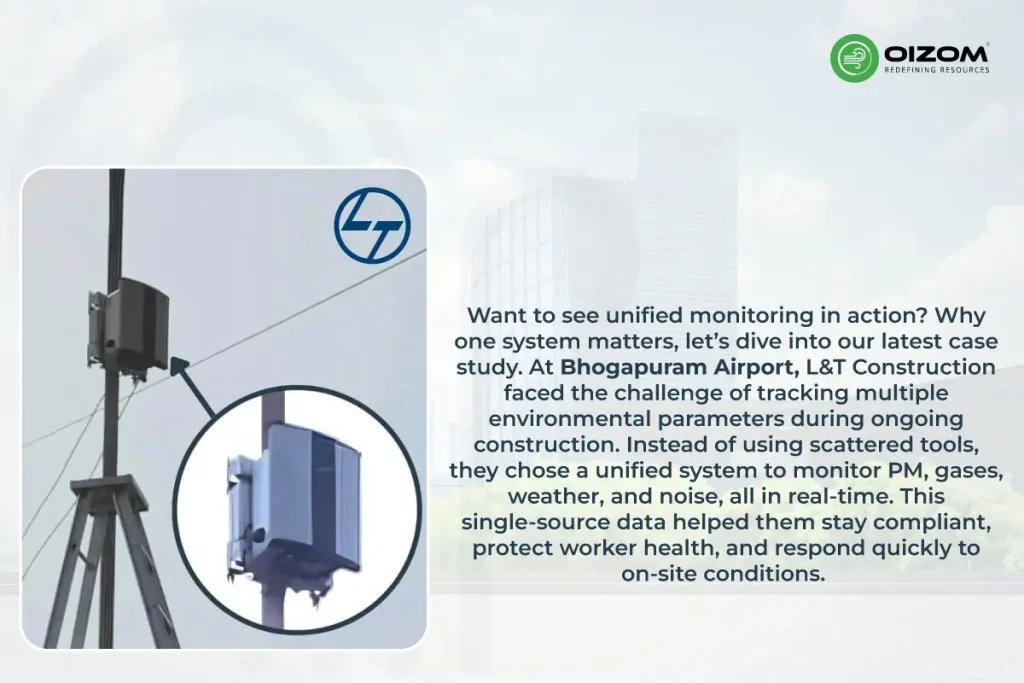
Comparison: Traditional Monitoring vs Polludrone Unified Monitoring System
| Parameter | Traditional Method | With Polludrone |
|---|---|---|
| Particulate Matter (PM) | Separate the PM monitor with individual enclosures | Integrated laser scattering sensor (PM1, PM2.5, PM10, PM100) |
| Gases | Multiple analyzers for each gas | Electrochemical + NDIR combo in one module |
| Noise | A dedicated noise meter is required | Built-in Class 2 Noise Sensor (Class 1 optional) |
| Weather | Standalone weather station setup | Built-in met sensors (Temp, Humidity, Wind, Rain, solar radiation) |
| Power & Cabling | Multiple power and comms sources | Single power input with a unified interface, and works well with solar |
| Data Access | Different dashboards for each device | Single unified dashboard via Envizom |
| Maintenance | Frequent servicing for multiple units | Centralized maintenance with modular upgrades |
Conclusion: Smarter Monitoring Starts with the Right Tools
Understanding air quality requires more than just measuring PM levels; it’s about capturing the full environmental picture. Polludrone air quality monitoring system simplifies this by bringing PM, gas, noise, and weather monitoring into a single, compact system, using reliable technologies like laser scattering, electrochemical, and NDIR sensors, and precision meteorological modules.
This unified approach not only reduces infrastructure costs but also improves data accuracy through real-time, multi-parameter correlation. It empowers smart cities, industries, and researchers to make informed decisions that protect public health and support regulatory compliance.
As environmental intelligence becomes central to urban innovation, Polludrone Data Accuracy and Integration with Smart Systems plays a critical role in enabling seamless, scalable, and future-ready air quality solutions. Looking ahead, Polludrone is built to evolve, with modular upgrades and seamless integration with IoT platforms, it’s ready for the next wave of AI-powered environmental analytics and predictive pollution modeling. Because smarter decisions start with complete, accurate data, all in one system.
Want to learn more about how Oizom Polludrone measures PM, Gases, Noise, and Weather, and how it can fit into your monitoring setup? Get in touch with our experts today; we’re happy to help!
FAQs
Every gas and PM sensor is factory-calibrated and traceable to NIST standards and BAM method, with options for on-site recalibration using standard gas kits.
Yes, it is designed with IP66-rated enclosures and can operate in temperatures from -20°C to +60°C.
Minimal. Modular sensors can be replaced without removing the device, and maintenance alerts are automated via Envizom.
Polludrone uses MCERTS-certified PM sensors and follows USEPA guidelines for calibration and quality assurance.
Yes. Polludrone supports IoT protocols (4G, RS485, Modbus) for seamless integration with SCADA or cloud platforms.

